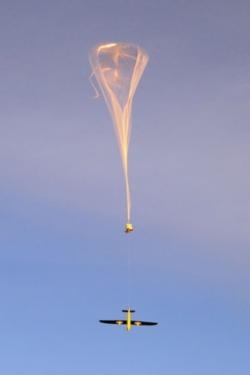Navy Concept Is To Launch Small Autonomous UAVs From
Manned, Unmanned Aircraft
The Naval Research Laboratory Vehicle Research Section has
successfully completed flight tests for the Autonomous Deployment
Demonstration (ADD) program. The final demonstration took place
September 1 at the Yuma Proving Grounds, Yuma, AZ, and consisted of
a series of eight balloon-drops at altitudes of up to 57,000 ft,
delivering sensor-emplacement Close-In Covert Autonomous Disposable
Aircraft (CICADA) vehicles within 15 feet of their intended landing
locations.
US Navy Photo

The ADD concept is to enable small unmanned air vehicles (UAV)
equipped with sensor payloads to be launched from aircraft (manned
or unmanned), balloons, or precision guided munitions, and
dispersed in selectable patterns around designated areas.
"The mission profile is straight forward," says Chris Bovais,
aeronautical engineer and flight test coordinator, NRL Vehicle
Research Section. "The CICADA is dropped from another airborne
platform, flies to a single waypoint, and then enters an orbit. It
descends in that orbit until it reaches the ground."
The NRL developed CICADA Mark III UAV is a glider; it has no
propulsion source onboard, therefore. It requires another airborne
platform to get it to an altitude such that it can glide to its
destination. Its lack of a motor and small size, make it nearly
undetectable in flight.
The ADD field trials successfully demonstrate that the CICADA
can perform a precision delivery of a notional payload after being
dropped from a 'mother-ship' or being carried aloft by a balloon.
Standoff distances of 30 nautical miles and altitudes up to 57,000
feet were demonstrated, with an average landing error of 15 feet
from the commanded location.
During the demonstration, the UAV ensemble was lifted to
altitude using balloons operated by Aerostar International. A
UASUSA built Tempest UAV, with two CICADA vehicles attached on
wing-mounted pylons, was carried aloft to altitudes approaching
60,000 feet. The Tempest mother ship was released from the balloon,
autonomously executed a pull-up maneuver, and then carried the two
CICADAs to a drop location. Each CICADA vehicle was then released
from the mother ship and autonomously flew to the preprogrammed
target waypoint.
"Many remote sensors are currently hand emplaced," said Bovais.
"The CICADA allows for the low-cost delivery of multiple
precision-located sensors without placing the warfighter in harm's
way."
The CICADA Mark III is a unique vehicle. The airframe is simply
a printed circuit board also serving as the autopilot, the first
known multi-purpose airframe/avionics implementation of its kind.
This novel construction method significantly reduces assembly time,
minimizes wiring requirements, and enables the manufacture of
low-cost and rugged micro air vehicles. The airframe shape is
easily scaled to accommodate various payload sizes and potential
acoustic, magnetic, chemical/biological and SIGINT sensors. Unique
to this construction technique, additional electronic payloads can
be inserted into the system by updating the printed circuit board
artwork and 're-winging' the aircraft.
A custom autopilot for the CICADA, both hardware and software,
was developed by the Vehicle Research Section to be both
inexpensive and robust. The only flight sensors are a 5Hz GPS
receiver and a two-axis gyroscope. Although having minimal sensors,
the navigation solution and the flight controller proved to be
quite robust during in-flight testing, routinely recovering from
tumbling launches. The flight controller also included a custom NRL
algorithm that accurately estimated wind speed and magnitude,
despite having no air data sensors onboard.
 Airborne 11.05.25: Tesla Flying Car?, Jepp/ForeFlight Sold, A220 Troubles
Airborne 11.05.25: Tesla Flying Car?, Jepp/ForeFlight Sold, A220 Troubles Airborne 11.07.25: Affordable Expo Starts!, Duffy Worries, Isaacman!
Airborne 11.07.25: Affordable Expo Starts!, Duffy Worries, Isaacman! Aero-News: Quote of the Day (11.05.25)
Aero-News: Quote of the Day (11.05.25) ANN's Daily Aero-Linx (11.05.25)
ANN's Daily Aero-Linx (11.05.25) NTSB Prelim: Cirrus Design Corp SR22
NTSB Prelim: Cirrus Design Corp SR22



